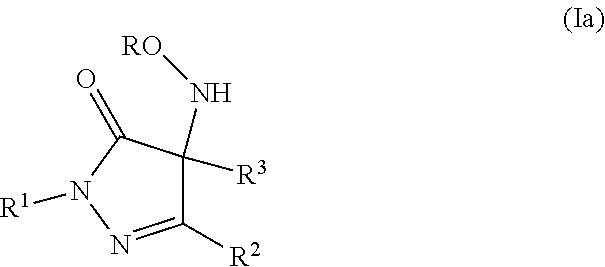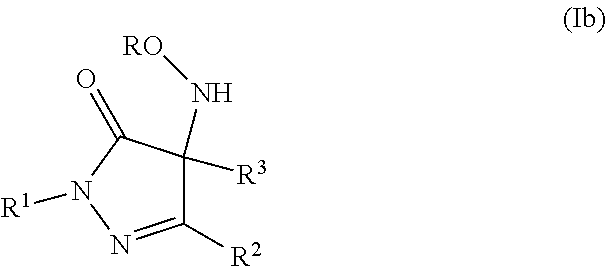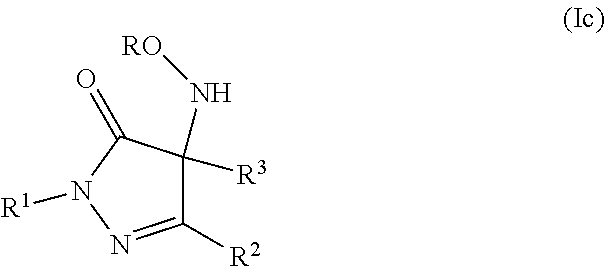Pyrazolone derivatives as nitroxyl donors
a technology of nitroxyl donors and derivatives, which is applied in the direction of cardiovascular disorders, organic chemistry, drug compositions, etc., can solve the problems that the non-ideal solid state stability of nitroxyl donors has impeded the development of oral dosage forms
- Summary
- Abstract
- Description
- Claims
- Application Information
AI Technical Summary
Benefits of technology
Problems solved by technology
Method used
Image
Examples
example 1
1 [4-(Hydroxyamino)-4-methyl-3-(pyridin-3-yl)-4,5-dihydro-1H-pyrazol-5-one]
1.1 2-Methyl-3-oxo-3-(pyridin-3-yl)propanoate
[0449]2-Methyl-3-oxo-3-(pyridin-3-yl)propanoate was synthesized from methyl 3-oxo-3-(pyridin-3-yl)propanoate according to General Method 6 and was purified by silica gel chromatography eluting with 0-40% Heptane:Ethyl acetate to yield the title compound as a yellow oil (1.505 g, 98% yield). LC-MS tR=0.78 min, [M+H]+=194, 1H NMR (500 MHz, Methanol-d4) δ 9.15-9.11 (m, 1H), 8.77-8.74 (m, 1H), 8.43-8.38 (m, 1H), 7.63-7.57 (m, 1H), 4.66 (q, J=7.0 Hz, 1H), 3.67 (s, 3H), 1.44 (d, J=7.0 Hz, 3H).
1.2 4-Methyl-3-(pyridin-3-yl)-1H-pyrazol-5-ol
[0450]4-Methyl-3-(pyridin-3-yl)-1H-pyrazol-5-ol was synthesized from 2-methyl-3-oxo-3-(pyridin-3-yl)propanoate and hydrazine hydrate according to General Method 1 and was used directly without additional purification (994 mg, 74% yield). [M+H]+=176, 1H NMR (500 MHz, DMSO-d6) δ 11.90 (br.s, 1H), 9.62 (br. s, 1H), 8.76 (d, J=1.6 Hz, 1H), 8....
example 2
2 [3-[4-(Hydroxyamino)-4-methyl-5-oxo-4,5-dihydro-1H-pyrazol-3-yl]pyridin-1-ium-1-olate]
2.1 3-(4-{[(tert-Butoxy)carbonyl](hydroxy)amino}-4-methyl-5-oxo-4,5-dihydro-1H-pyrazol-3-yl)pyridin-1-ium-1-olate
[0453]To a solution of tert-butyl N-hydroxy-N-[4-methyl-5-oxo-3-(pyridin-3-yl)-4,5-dihydro-1H-pyrazol-4-yl]carbamate (1.07 g, 3.06 mmol) in DCM (30 mL) cooled to 0° C. was added 3-chlorobenzenecarboperoxoic acid (792 mg, 4.59 mmol) and the reaction mixture was stirred for 18 hours at room temperature after which time a white precipitate was collected and was washed with DCM (2×100 mL) and ethyl acetate (50 mL) before purification by acidic reverse phase C18 chromatography to yield the desired compound as a white solid (305 mg, 25% yield). 1H NMR (500 MHz, Methanol-d4) δ 8.86-8.80 (m, 1H), 8.40-8.33 (m, 1H), 8.11-8.05 (m, 1H), 7.67-7.58 (m, 1H), 1.65 (s, 3H), 1.33 (s, 9H).
2.2 3-[4-(Hydroxyamino)-4-methyl-5-oxo-4,5-dihydro-1H-pyrazol-3-yl]pyridin-1-ium-1-olate
[0454]3-[4-(Hydroxyamino)-4-...
example 3
3 [Ethyl 4-[4-(hydroxyamino)-3-methyl-5-oxo-4,5-dihydro-1H-pyrazol-4-yl]butanoate]
3.1 6-Ethyl 1-methyl 2-acetylhexanedioate
[0455]To a suspension of methyl 3-oxobutanoate (0.93 mL, 8.61 mmol) and potassium carbonate (1.67 g, 12.06 mmol) in DMF (10 mL) was added ethyl 4-bromobutanoate (1.61 mL, 11.2 mmol) and the mixture was stirred at room temperature for 18 hours, after which time, the mixture was partitioned between ethyl acetate (30 mL) and water (20 mL). The organic layer was separated, the aqueous layer extracted into ethyl acetate (2×30 mL) and the combined organic layers were washed with brine (20 mL), dried over sodium sulfate, filtered and concentrated under reduced pressure to yield the crude product as a viscous yellow oil which was purified by silica gel chromatography eluting with a gradient of 0-20% ethyl acetate:Heptane to yield the title compound as an orange oil (1.05 g, 53% yield). 1H NMR (250 MHz, Chloroform-d) δ 4.12 (q, J=7.1 Hz, 2H), 3.73 (s, 3H), 3.44 (t, J=7.3...
PUM
| Property | Measurement | Unit |
|---|---|---|
| Fraction | aaaaa | aaaaa |
| Fraction | aaaaa | aaaaa |
| Fraction | aaaaa | aaaaa |
Abstract
Description
Claims
Application Information
 Login to View More
Login to View More - R&D
- Intellectual Property
- Life Sciences
- Materials
- Tech Scout
- Unparalleled Data Quality
- Higher Quality Content
- 60% Fewer Hallucinations
Browse by: Latest US Patents, China's latest patents, Technical Efficacy Thesaurus, Application Domain, Technology Topic, Popular Technical Reports.
© 2025 PatSnap. All rights reserved.Legal|Privacy policy|Modern Slavery Act Transparency Statement|Sitemap|About US| Contact US: help@patsnap.com



